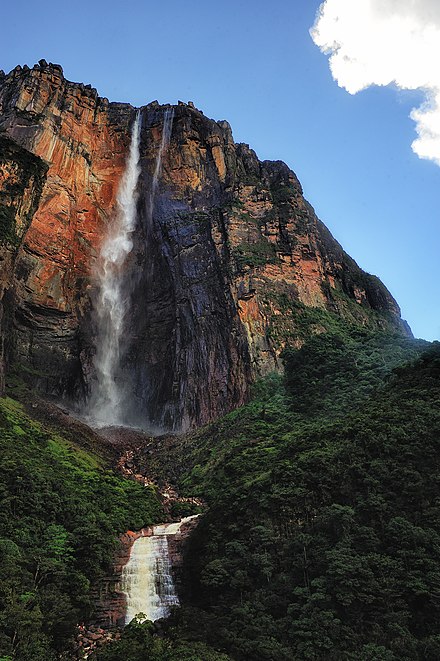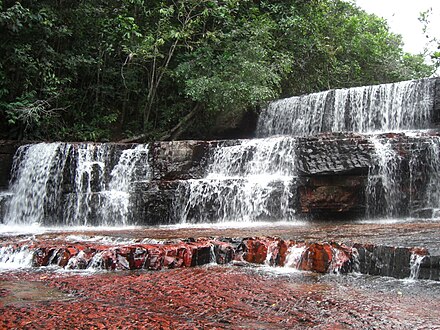Canaima National Park - national park in Venezuela
Canaima National Park is in the Gran Sabana region of Venezuela, in the southern Bolivar State. The park is a UNESCO World Heritage site.
Understand
Canaima National Park is the gateway to Angel Falls. Although other waterfalls and lagoons can be visited from Canaima camp, the main reason tourists fly here is for the three-day, two-night trips to the base of Angel Falls.
History
Landscape
Flat, grassy savannas with dramatic tepuis (table-top mountains), waterfalls and moriche palms. Angel Falls is located on the side of the largest of the Venezuela's tepuis known as Auyan-tepui.
Flora and fauna
There is an incredible variety of tropical wildlife in the area, including monkeys, poison arrow frogs and hundreds of species of orchids. Mammals in the area are generally difficult to spot but include giant anteaters, armadillos, porcupines, three-toed sloths, otters, jaguars, pumas, tapirs and capybaras. Some of the birds that you can see are king vulture, paradise tanager, white bellbird, cock of the rock, musician wren, great kiskadee, bananaquit, velvet browed brilliant, capuchinbird, sooty-capped hermit, and blue-cheeked parrot.
Climate
Tropical, with frequent rainstorms. The driest time of year - when the Falls may be just a trickle - is from December to April.
Get in
 There are no overland routes to the settlement of Canaima. The only access is by air. Avior and Rutaca fly to and from Ciudad Bolívar and Caracas.
There are no overland routes to the settlement of Canaima. The only access is by air. Avior and Rutaca fly to and from Ciudad Bolívar and Caracas.
Access to the Sector Occidental is by air into villages like Canaima. However, the Sector Oriental (eastern sector) has road access via the Troncal 10. The new El Dorado-Luepa road to Santa Elena de Uairen connects the east of the park with the Brazilian frontier and a branch of it reaches the small village of Kanavayen, which is close to the spectacular Aponwao Falls.
For a trip to the falls, it is possible to charter a plane to Canaima from Caracas, Margarita Island, or Ciudad Bolivar airports, and then organize a tour of the falls on your own. In practice, the simplest thing to do is sign up for a tour that takes care of the details. If you book a tour from your home country, it will be more expensive and even booking a tour from Caracas will cost more. It is cheapest to book a tour from the airport in Ciudad Bolivar. Nearly all of the Angel Falls tours operate out of this city, and their prices include the cost of a plane that flies from Ciudad Bolivar to Canaima. Expect to pay approximately US $250 for a three-day, two-night tour that brings you to the falls. Most tours booked on your own from Ciudad Bolivar airport will include a fly-by of the falls on the way to Canaima camp.
There are also regular flights leaving from Puerto Ordaz - tours and accommodation can easily be arranged in Canaima upon arrival.
Fees and permits
At arrival at the Canaima airport an entrance fee is collected.
Visitors flying out to Canaima National Park must also prove they have received a yellow fever vaccination. Those who cannot prove this will be given the vaccination in the airport at Ciudad Bolivar or Puerto Ordaz for free.
Get around
The small settlement of Canaima is negotiable by foot. Trips up to the Falls, however, will be in a dugout canoe, or curiara. The 30-minute or so walk from the closest point on the river to the base of the falls is not easy going because of large tree roots on the path - take sports shoes or kicking boots for this hike.
See
Angel Falls
 Angel Falls or Salto Ángel is the world's second highest waterfall, dropping a total of 978m from the summit of the Auyan Tepuy, and with an 807m uninterrupted drop (which is actually the highest drop).
Angel Falls or Salto Ángel is the world's second highest waterfall, dropping a total of 978m from the summit of the Auyan Tepuy, and with an 807m uninterrupted drop (which is actually the highest drop).
It is known as Parekupa-meru by the local Pemon Indians but gained the Angel name after US pilot Jimmy Angel crash-landed on the Auyan Tepuy while searching the area for gold in 1937. Instead, he found the spectacular waterfall. After 11 days of trekking, he reached Kamarata and made his find public. His plane was later recovered and can be seen in front of the airport at Ciudad Bolivar. After his death in 1956, his ashes were sprinkled over Angel Falls.
Angel Falls is in the Gran Sabana region of Venezuela. The area is filled with grasslands, with some dense jungle along the course of the rivers and at the base of the numerous tepuis, or flat-topped mountains. Angel falls is located on the side of the largest of the Venezuela's tepuis known as Auyan-tepui.
There is an incredible variety of tropical wildlife in the area, including monkeys, poison arrow frogs and hundreds of species of orchids. Aside from the monkeys, mammals in the area are generally difficult to spot but include giant anteaters, armadillos, porcupines, three-toed sloths, otters, jaguars, pumas, tapirs and capybaras.
Angel Falls is deep within the National Park. The falls are about 5 hours' ride in a dugout canoe upstream from Canaima village. Most of the Park's attractions can only be visited with a guided tour from Canaima. These can be booked from outside Venezuela, from Caracas, or from Ciudad Bolivar but prices are much more competitive in Ciudad Bolivar. Most tours that take you to the foot of the falls are two nights (one in Canaima, one at the falls) and three days, and combine all of the three elements below (and also include food and transport). Alternatively you can hire shorter tours just to go up to Angel Falls and back again. A typical tour will include the flight to Canaima, and then three days of meals and (very basic) accommodation at the various campsites along the river towards the falls. The trip involves several hours in a dugout canoe and a few hours hiking through gallery forest to the main viewpoint below the falls. Most tour guides speak Spanish with limited English.
- Two-day tours run to the foot of the falls by motorized dugout canoe (curiara). The first day a 5- or 6-hour boat ride will lead you to the base camp. From there it's a one-hour walk to the foot of waterfall. Here you can take pictures and swim. The night will be spent in hammocks and the next day another five hours will bring you back to Canaima. Although the plane flights are arranged separately, all tours are run by a cooperative that arranges tours as boats fill up. Angel Falls is one of the few locations in Venezuela where an individual traveller does not have to wait to become part of a tour group.
- A half day tour brings you to Isla Anatoly, very close to Canaima village, where some other waterfalls are visited such as Salto Sapo. Some of them have a water curtain that one can walk behind.
- Just west of Canaima is a beautiful lagoon with water stained a tea colour by the vegetation in the area, and with a nice view of the waterfalls and tepuy (tabletop) mountains.
Do
The trip towards the fall itself has many attractions. The boat rides and walks through the jungle offer a unique view of Venezuelan flora, fauna, and terrain. If the water flow is mild enough, you can swim in the small pool that forms below the falls.
Apart from trips to Angel Falls, the Canaima National Park offers some challenging trekking, including trips to the 700 km² plateau of Auyan-tepui, which can be arranged in Ciudad Bolivar. The trek to the top from the tiny village of Uruyen takes three days on rough tracks, and the final climb up a cleft in the massive rock wall is a tough scramble, but the rewards are immense - the landscape is surreal, with clumps of insect-eating pitcher plants clinging to the bare rock, and unlike Mount Roraima, you'll barely meet another soul. Trips typically spend a couple of days on the top, and take 2 days to return to either Uruyen or Kavac. The weather can be wet, and chilly on the tepui - bring a warm fleece and some waterproofs!
The tourist village of Kavac has a bar, a small shop selling crafts, and traditional huts with comfortable beds or hammocks. Stay for a morning before your flight out and someone will offer to show you to the "caves", really a narrow canyon leading to a waterfall and a refreshing plunge pool.
Buy
Eat
- Moriche palm fruits. Miniature pineapples. Red and scaly. Harvest starts in November.
Drink
The water from the waterfall- refreshing, pure and delicious.
Sleep
- Canaima Camp, Canaima (Comunidad Indígena Kanaimö), 6.24165°, -62.851949°, +584142877554. Check-in: 9AM, check-out: noon. Canaima Camp has 120 rooms built as cottages, divided into double, double, triple and quadruple rooms, which remain an excellent architectural approach that respects the natural landscape and has all the necessary comforts and conveniences for guests, daily maid service, hot water, electricity and private baths. In a viewpoint on the Laguna de Canaima is the restaurant, where you can enjoy an exquisite and varied cuisine. 120
- Campamentos in Canaima, +58 286 9622359. Check-in: 9AM, check-out: any. Great, comfortable place. They offer excursions and have a very good cuisine. Owned by descendants of Jungle Rudy, who discovered the Angel Falls in the 1950s.
Camping
Camping is not allowed and this is strictly enforced in the region around Angel Falls.

